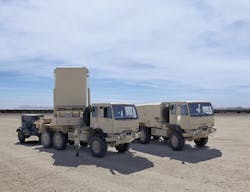Army asks Lockheed Martin to upgrade AN/TPQ-53 radar with counter-drone capability
ABERDEEN PROVING GROUND, Md. - Radar experts at Lockheed Martin Corp. are upgrading the company's AN/TPQ-53 air-defense, fire-control radar to detect, classify, track, and pinpoint enemy unmanned drones without posing a risk to nearby U.S. and allied aircraft and military forces.
Officials of the U.S. Army Contracting Command at Aberdeen Proving Ground, Md., announced a $27.8 million contract to the Lockheed Martin Rotary and Mission Systems segment in Syracuse, N.Y., to add counter-unmanned aerial system (C-UAS) capability to the AN/TPQ-53 radar.
Now Army experts are asking Lockheed Martin to make software upgrades to the AN/TPQ-53 to enhance its reliability against enemy drones and other unmanned aircraft, as well as integrate an off-the-shelf identification-friend-or-foe (IFF) subsystem to the radar.
The Q-53 - designed and built by Lockheed Martin Rotary and Mission Systems - is a solid-state phased-array radar that detects, classifies, tracks, and determines the location of enemy indirect fire weapons like rockets, artillery shells, and mortars in either 360- or 90-degree modes. This system is replacing the aging U.S. Army AN/TPQ-36 and AN/TPQ-37 medium- range radars. Lockheed Martin builds the Q-53 radar in Syracuse and Owego, N.Y.; Moorestown, N.J.; and Clearwater, Fla.
To upgrade the radar to detect and track enemy drones, Lockheed Martin will modify the existing AN/TPQ-53 software to detect, track, and identify enemy drones hindering existing waveforms for detection and tracking. The goal is to integrate these upgraded counter- drone capabilities with minimal hardware modification and no increase to manpower requirements of the existing AN/TPQ-53 system.
In addition, Lockheed Martin will modify existing AN/TPQ-53 software interfaces to the Army's Advanced Field Artillery Tactical Data System (AFATDS) and Forward Area Air Defense Command and Control (FAAD C2) system to provide enemy drone information to counter-fire batteries.
Lockheed Martin will demonstrate the upgraded AN/TPQ-53 radar with counter-drone capabilities during Army field exercises in January and June 2017, and will provide the final fieldable configuration for assessment in January 2018. The final fieldable system should be ready by June 2018.
On this contract, Lockheed Martin will do the work in Syracuse, N.Y., and should be finished by 2018.
FOR MORE INFORMATION visit Lockheed Martin online at www.lockheedmartin.com/us/rms.html.

